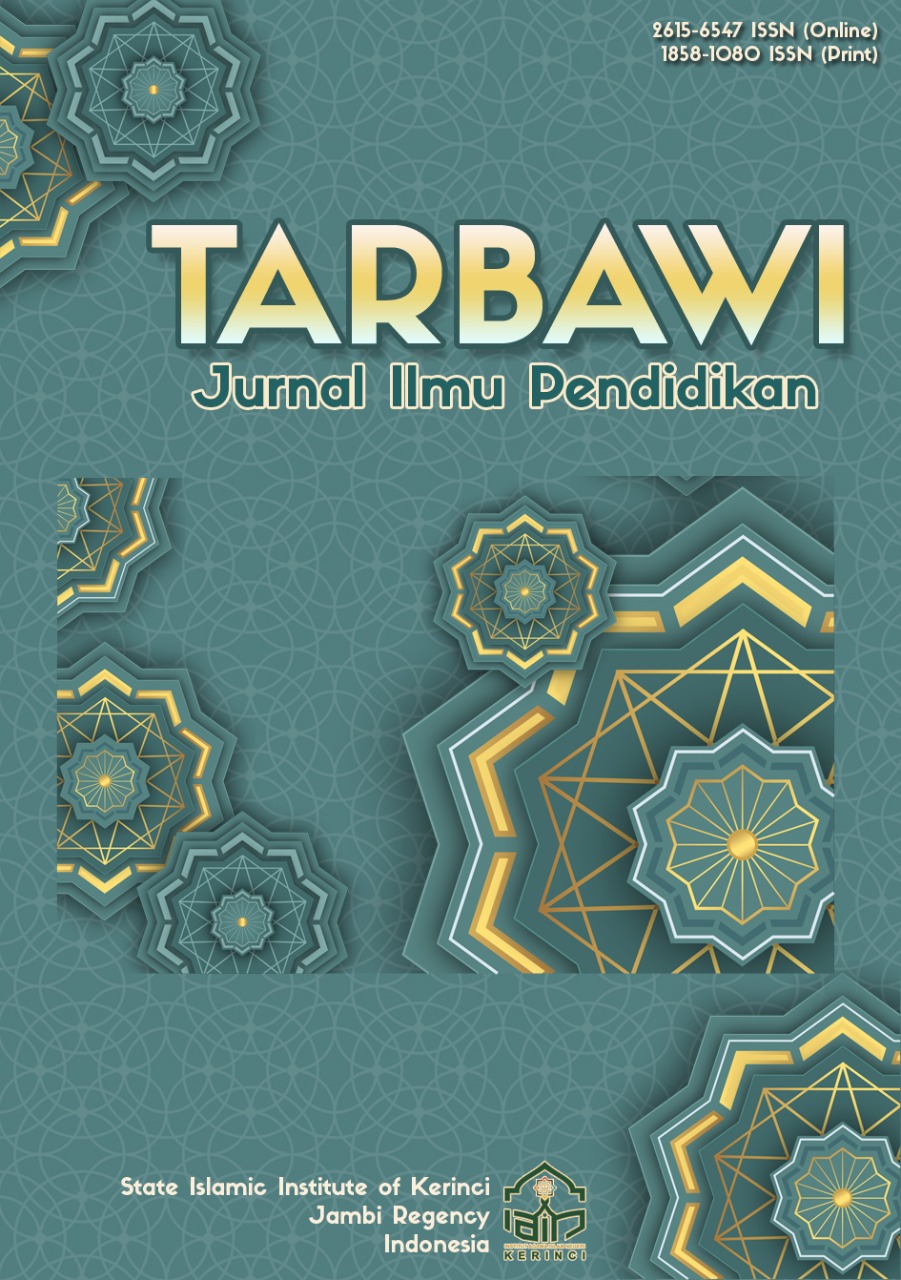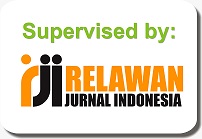Analysis of the Level of Motivation to Learn Science Considered from 4 Main Indicators: SE, IE, CDL, and CCI
DOI:
https://doi.org/10.32939/tarbawi.v20i2.4410Keywords:
Cross-Cultural Interactions, Connection to Daily Life, Interest and Enjoyment, Motivation for Learning Science, Self-EfficacyAbstract
Learning motivation is one of the important factors that influence the success of the learning process, especially in Natural Science (IPA) subjects that require an in-depth understanding of concepts. This study aims to analyze the level of motivation to learn science in 5th-grade students at MIN 3 Lampung Utara. Learning motivation is measured based on four main indicators, namely Self-Efficacy (SE), Interest and Enjoyment (IE), Connection to Daily Life (CDL), and Cross-Cultural Interactions (CCI), which are adapted from Ginzburg & Barak's research (2023). Data were collected by distributing questionnaires directly to students, and the data were analyzed using the Rasch model. The results showed that the motivation to learn science at MIN 3 Lampung Utara was in the high category, with an average percentage of motivation of 71.67%. The results of the analysis using the Rasch model show person reliability of 0.78 and item reliability of 0.85, which indicates that the instrument used has good consistency in measuring science learning motivation. Furthermore, an in-depth analysis of the four indicators showed that overall student motivation was high. However, the Connection to Daily Life (CDL) indicator, which reflects students' ability to connect science material with daily life, showed the lowest score compared to other indicators. This finding has important implications for educators and curriculum developers to improve the relevance of science learning to students' daily lives. Therefore, further research is needed to explore the factors that influence the low connection between science materials and students' daily life contexts.
Downloads
References
Altukhi, Z. M., & Aljohani, N. F. (2023). Using Descriptive Analysis to Find Patterns and Trends: A Case of Car Accidents in Washington D.C. International Journal of Advanced Computer Science and Applications. https://doi.org/10.14569/ijacsa.2023.0140527
Amal, H., Ishak., S., Amirah, A., Muhamad, H., Yahya., S., Moidin., M., & Sahri. (2022). Determining the Construct Validity and Reliability of Philanthropic Behaviour Scale using Rasch Model. International Journal of Asian Social Science. https://doi.org/10.55493/5007.v12i10.4621
Ana, R., Falentina., M., Saptasari., S., & Endah, I. (2021). Keterampilan Berpikir Kritis melalui Penerapan Model Pembelajaran Inkuiri Terbimbing di Kelas XI IPA. In Jurnal Pendidikan: Teori, Penelitian, dan Pengembangan. https://doi.org/10.17977/JPTPP.V5I10.14100
Anirban, T., Sougata, K., Burman., G., Bera., J., Mukherjee., M., Maji., D., & Santra. (2023). A Cross-sectional Observational Study of the Etio-pathology, Socioeconomic Distribution and Clinical Pictures of Ectopic Pregnancy in a Tertiary Medical College and Hospital in Bankura, West Bengal, India. Journal of Medical Sciences and Health. https://doi.org/10.46347/jmsh.v9i2.23.136
Ann, M., Novak., D., & F., T. (2022). Supporting the development of scientific understanding when constructing an evolving explanation. Disciplinary and Interdisciplinary Science Education Research. https://doi.org/10.1186/s43031-021-00043-w
Anna, R., Diah, Y., & Suryarini. (2024). Science problem solving in elementary schools through the application of project-based learning. Journal of Research in Instructional. https://doi.org/10.30862/jri.v4i1.278
Asrizal, A., & Usmeldi, U. (2023). Effect of STEM Integrated Science Learning on Scientific Literacy and Critical Thinking Skills of Students: A Meta-Analysis. Jurnal Penelitian Pendidikan IPA (JPPIPA. https://doi.org/10.29303/jppipa.v9i6.2614
Cucu, H., Aang, R., Didik, P., Razali, R., & Mia, R. (2023). Motivating Active Learning in Physical Education: Critical Thinking. European Journal of Educational Research. https://doi.org/10.12973/eu-jer.12.2.1137
Dhea, R., Ari, S., & Sahrun, N. (2024). Hubungan Antara Motivasi Belajar dan Prestasi Akademik Dalam Mata Pelajaran IPA di Sekolah Dasar. Jurnal Bintang Pendidikan Indonesia. https://doi.org/10.55606/jubpi.v2i3.3108
Edward, P., & K., T. (2023). A Qualitative Research Approach is an Inevitable Part of Research Methodology: An Overview. International Journal For Multidisciplinary Research. https://doi.org/10.36948/ijfmr.2023.v05i03.3178
Enas, S., Ali, A., Kamal, J., I, B., Noor, L., & Abu, K. (2020). Examining the adequacy of an exit exam to measure diploma students’ achievement: Rasch analysis. Humanities and Social Sciences. https://doi.org/10.18510/HSSR.2020.82E22
Erik, L. (2023). Questionnaire-taking motivation: Using response times to assess motivation to optimize on the PISA 2018 student questionnaire. International Journal of Testing. https://doi.org/10.1080/15305058.2023.2214647
Erna, N., & Sarah, D. (2023). Application of The Learning Strategies and Motivation Questionnaire (LEMO) at the University: Reliability and Relation to First-year GPA. International Journal of Higher Education. https://doi.org/10.5430/ijhe.v12n6p21
Fanglei, L. (2024). A Study on the Dilemma and Countermeasures of Science Teaching in Primary Schools. International Journal of Education and Humanities. https://doi.org/10.54097/q68khs43
Gabriela, N. (2022). Theoretical principles of forming learning motivation in students. European International Journal of Multidisciplinary Research and Management Studies. https://doi.org/10.55640/eijmrms-02-10-33
Gail, S., Sally, G., & Ceri, W. (2023). Waiting in the Wings: The Enactment of a Descriptive Phenomenology Study. The International Journal of Qualitative Methods. https://doi.org/10.1177/16094069231207012
Heng, E., How., C., Chew, L., Siti, N., Binti, B., Kosnandi., N., Syuhada, B., Binti, Z., & Abidin. (2024). Factors of Increasing Students’ Motivation in Educational Settings: A Review. International Journal of Academic Research in Business & Social Sciences. https://doi.org/10.6007/ijarbss/v14-i1/20412
Hüner, Ş., & Yahya, F. (2020). Li̇kert veri̇leri̇ni̇n kullanildiği keşfedi̇ci̇ faktör anali̇zleri̇nde normalli̇k varsayimi ve faktör çikarma üzeri̇ndeki̇ etki̇si̇ni̇n spss, factor ve prelis yazilimlariyla sinanmasi. Business And Management Studies: An International Journal. https://doi.org/10.15295/BMIJ.V8I1.1395
Julie, V., Themistocles, T., Dimitrios, S., George, Z., & Papageorgiou. (2023). Conceptual understanding in science learning and the role of four psychometric variables: A person-centered approach. Frontiers in Psychology. https://doi.org/10.3389/fpsyg.2023.1204868
Junaidi, J., & Rohmani, R. (2024). 2. Effective Learning Strategies in Improving Elementary School Students’ Character: A Systematic Literature Review. International Journal of Multidisciplinary Approach Research and Science. https://doi.org/10.59653/ijmars.v2i03.885
Kassandra, I., Alcaraz., T., L., W., Elvan, C., Daniels., K., Robin, Y., Carmen, G., Richard, C., & Wender. (2020). Understanding and addressing social determinants to advance cancer health equity in the United States: A blueprint for practice, research, and policy. CA: A Cancer Journal for Clinicians. https://doi.org/10.3322/CAAC.21586
Kheirabadi, M., & Mirzaei, Z. (2019). Descriptive valuation pattern in education and training system: A mixed study.
Khoirun, N. (2022). Inovasi Pembelajaran IPA SD dengan Pemanfaatan Media KIT Alat Sederhana yang Berasal dari Lingkungan Sekitar Untuk Meningkatkan Kompetensi dan Kreativitas Siswa. Formosa Journal of Science and Technology. https://doi.org/10.55927/fjst.v1i2.693
Linacre, J. M. (2000). Winsteps. http://www.
M., C., Navarro-González., J., Padilla., I., & Benítez. (2024). Analyzing Measurement Invariance for Studying the Gender Gap in Educational Testing. European Journal of Psychological Assessment. https://doi.org/10.1027/1015-5759/a000820
Mohd, F., Ridzuan., H., Lian, L., Farah, A., Ahmad, F., Siti, N., Anissa, M., & Nasser. (2020). Rasch Analysis Model: Reliability and Validity of Superitem Test Instrument. International Journal of Academic Research in Progressive Education and Development. https://doi.org/10.6007/IJARPED/V9-I4/8166
Mondal, H., Swain1, S. M., & Mondal, S. (2022). How to conduct descriptive statistics online: A brief hands-on guide for biomedical researchers. Indian Journal of Vascular and Endovascular Surgery. https://doi.org/10.4103/ijves.ijves_103_21
Morris, S.-Y. & Jong. (2020). Promoting Elementary Pupils’ Learning Motivation in Environmental Education with Mobile Inquiry-Oriented Ambience-Aware Fieldwork. International Journal of Environmental Research and Public Health. https://doi.org/10.3390/IJERPH17072504
Münevver, B. (2023). A Comparison of the efficacies of differential item functioning detection methods. International Journal of Assessment Tools in Education. https://doi.org/10.21449/ijate.1135368
Na, H., Lee., H., & Joung, C. (2024). Analysis of single umbilical artery with concurrent congenital anomaly: Is it a risk factor for poor prognosis? A cross-sectional study. International Journal of Reproductive BioMedicine. https://doi.org/10.18502/ijrm.v22i2.15710
Nanda, N., Baiti., M., Amin., S., Aini., S., & Salminawati. (2023). The Importance of Teaching Elementary Students About the History of Science Development. Jurnal Basicedu. https://doi.org/10.31004/basicedu.v7i2.4909
Nasir, N. I. R. F., Arifin, S., & Damopolii, I. (2023). The analysis of primary school student’s motivation toward science learning. Journal of Research in Instructional, 3(2), 258–270. https://doi.org/10.30862/jri.v3i2.281
Nathaniel, H., & Benjamin, S.-K. (2020). A Unified Welfare Analysis of Government Policies. Quarterly Journal of Economics. https://doi.org/10.3386/W26144
NNajwa, S., Mohamad., N., & Moi, S. (2022). Learning motivation towards linear programming questionnaire for polytechnic diploma students. International Journal of Education, Psychology and Counseling. https://doi.org/10.35631/ijepc.747031
Oksana, L., & С., О. (2023). Motivational sphere of primary school students: Aspects of formation. Psihologìčnij žurnal. https://doi.org/10.31499/2617-2100.10.2023.285316
Omar, A., Ponce., J., Gomez-Galan., N., & Pagan-Maldonado. (2022). Qualitative research in education. International Journal of Educational Research and Innovation. https://doi.org/10.46661/ijeri.5917
Pathiah, F., Iman., N., & Fitriani. (2023). Improving Problem Solving Ability through A Scientific Approach on Grade VII MTs Students. Journal of Innovative Mathematics Learning. https://doi.org/10.22460/jiml.v6i4.16988
Rahmat, P., & Asrial., M. (2022). The Impact of Student Motivation on Students’ Science Process Skills. Journal of Education Research and Evaluation. https://doi.org/10.23887/jere.v6i4.52350
Roald, E., Gerhard, van, & Huyssteen. (2023). A Comparison of Statistical Tests for Likert-Type Data: The Case of Swearwords. Journal of Open Humanities Data. https://doi.org/10.5334/johd.132
Roxana, M., Manrique-Toro., M., Tatiana, A.-Y., José, R.-T., & Efrén, V.-C. (2024). Scientific Competencies and Research Skills as Common Threads in Science Learning. South Eastern European Journal of Public Health. https://doi.org/10.70135/seejph.vi.2011
Sherwin, E. & Balbuena. (2023). Application of the Rasch model in streamlining an instrument measuring depression among college students. International Journal of Assessment Tools in Education. https://doi.org/10.21449/ijate.1210479
Sigit, S., Mohammad, M., Baskoro, A., Prayitno., S., & Sutarno. (2024). Fostering critical thinking in science education: Exploring effective pedagogical models. International Journal of Advanced and Applied Sciences. https://doi.org/10.21833/ijaas.2024.07.016
Siti, S., Saidi., N., & Moi, S. (2019). Reliability and Validity Analysis of Statistical Reasoning Test Survey Instrument using the Rasch Measurement Model. Journal on Mathematics Education. https://doi.org/10.29333/IEJME/5755
Sri, M., Suwahono, S., Hanifah, S., Lis, S., & Ningrum. (2022). Validity Analysis Using the Rasch Model in the Development of Alkane Concept Test Instruments. JPPIPA (Jurnal Penelitian Pendidikan IPA. https://doi.org/10.29303/jppipa.v8i3.1383
Su, L., Loh., N., Aisah, J., Ng, K., & Thoe. (2022). Establishing the Validity and Reliability of a Program Evaluation Questionnaire using Rasch Measurement Model. In Dinamika: Jurnal Ilmiah Pendidikan Dasar. https://doi.org/10.30595/dinamika.v14i2.14786
Surtini, S., & Tatang, M. (2024). Teachers’ Pedagogic Competence in Strengthening Character Education of Students in Elementary Schools: Exploring Effective Strategies. Jurnal Paedagogy : Jurnal Penelitian dan Pengembangan. https://doi.org/10.33394/jp.v11i3.11904
Thanatcha, S., Thanin, R., & Krissana, K. (2024). Synthesis of Research on Science Learning Management Affecting Problem Solving Skills: Meta-Analysis. International Journal of Instruction. https://doi.org/10.29333/iji.2024.17419a
Thanh, H. (2023). Developing scientific competence for primary school students through experiential learning. International Journal of Education and Social Science Research. https://doi.org/10.37500/ijessr.2023.6301
Tysa, S., Rahmi., S., & Neviyarni. (2022). The role of Learning Motivation (Extrinsic and Intrinsic) and its Implications in the Learning Process. International Journal of Educational Dynamics. https://doi.org/10.24036/ijeds.v5i1.378
Vegi, I., Futri., R., Rosnawati., A., Rahim., M., & Marlina. (2022). Rasch Model Study on Mathematics Examination Test Using Item Response Theory Approach. International journal on emerging mathematics education. https://doi.org/10.12928/ijeme.v6i1.21761
Vincentas, L. (2022). Natural science education in primary school: Some significant points. Journal of Baltic Science Education. https://doi.org/10.33225/jbse/22.21.908
Yasuhiro, K., Elaine, C., & Pauline, G. (2021). Construction And factorial validation of a short version of the Academic Motivation Scale. British Journal of Guidance & Counselling. https://doi.org/10.1080/03069885.2021.1903387
Yihang, D. (2023). Descriptive Statistics and Its Applications. Highlights in Science, Engineering and Technology. https://doi.org/10.54097/hset.v47i.8159
Yijia, M. (2024). Analysis Learning Motivation from Internal and External Perspectives: Recommendations Based on Maslow’s Hierarchy of Needs Theory. Lecture Notes in Education Psychology and Public Media. https://doi.org/10.54254/2753-7048/39/20240688
Zhang, F., Bae, C. L., Broda, M. D., & Koenka, A. C. (2023). Factor Structure of Student Science-Learning Motivation: Evidence from TIMSS U.S. Data. Sustainability, 15(17), 13230. https://doi.org/10.3390/su151713230
Downloads
Published
Issue
Section
License
Copyright (c) 2024 Mar'atus Sholihah, Rohmani Rohmani, Irawan Suprapto

This work is licensed under a Creative Commons Attribution-ShareAlike 4.0 International License.









